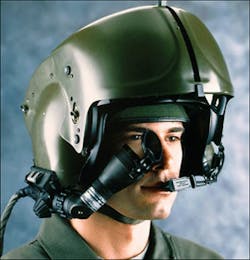Army awards $13.2 million contract to Elbit to provide Apache targeting helmets to Indonesia
Officials of the Army Contracting Command at Redstone Arsenal, Ala., announced a $13.2 million contract to Elbit earlier this month to provide 300 Apache Aviator Integrated Helmets (AAIH) for foreign military sales to Indonesia.
The Apache Aviator Integrated Helmet is a key component of the AH-64E's Integrated Helmet and Display Sight System (IHADSS)-21 system for the Apache Guardian attack helicopter. Essentially it enables Apache crews to slave on-board guns and missiles to the helmet. Crews aim weapons simply by looking at targets.
The new helmet, also used by U.S. Army Apache crews, is an integrated helmet, display, and sight system with improved safety features and comfort that provides Apache crews with situational awareness and targeting information.
The Elbit IHADSS is a monocular system for attack helicopter pilots that is compatible with the Apache's Modernized Target Acquisition Designation Sight/Pilot Night Vision Sensor (M-TADS/PNVS) electro-optical system from Lockheed Martin Corp.
The display unit attaches to the side of the helmet and feeds pilotage, navigation, and weapon-aiming symbology and imagery from the Apache's nose-mounted infrared camera to the crew member's right eye via a half-mirror, optical combiner.
The helmet, designed for use with night vision goggles, features a 40-by-30-degree field of view electro-optical head tracker. It slaves turreted weapons, missile seekers, and gimbaled night-vision sensors to the pilot’s line-of-sight.
In addition the helmet displays real-world-sized video imagery from night-vision sensors, as well as flight information and fire-control symbology directly in front of the pilot’s eye. It enables cueing between the aircraft’s crew members.
Related: Elbit to provide spare circuit cards for Apache helicopter helmet-mounted targeting system
The helmet also provides virtual head up display (HUD) capability; can be operated independently from each of the Apache's two cockpits, or cooperatively from both cockpits; and can be bore sighted on the ground or in flight.
This helmet display system enables Apache pilots to fly nighttime nap-of-the-earth missions by pointing a night vision sensor with natural head movements only. It can cue the other crew members line of sight toward the target, and point target acquisition sensors toward the target. In addition the helmet can enable an Apache crew member to observe common video imagery as seen by the other crew member.
Last October Elbit announced a $12.7 million contract to provide AAIH systems to the U.S. Army. On the contract announced earlier this month Elbit will do the work in Fort Worth, Texas, and should be finished by April 2017.
For more information contact Elbit Systems of America online at www.elbitsystems-us.com, or the Army Contracting Command-Redstone at www.acc.army.mil/contractingcenters/acc-rsa.

